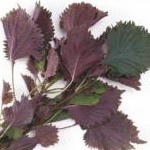
Perilla extract
Plant source :Perilla nankinensis decue
Specification : 5:1, 10:1
Appearence :Brown yellow powder
Introduction:
Perilla is the common name of the herbs of the genus Perilla of the mint family, Lamiaceae. In mild climates, the plant reseeds itself. There are both green-leafed and purple-leafed varieties, which are generally recognized as separate species by botanists. The leaves resemble stinging nettle leaves, but are slightly rounder in shape. Its essential oils provide for a strong taste whose intensity might be compared to that of mint or fennel. It is considered rich in minerals and vitamins, has anti-inflammatory properties, and is thought to help preserve and sterilize other foods. Like basil and coleus, it is a member of the mint family.
The essential oil extracted from the leaves of perilla by steam distillation consists of a variety of chemical compounds, which may vary depending on species. The most abundant, comprising about 50–60% of the oil, is perillaldehyde which is most responsible for the aroma and taste of perilla. Other terpenes, such as limonene, caryophyllene, and farnesene, are common, as well.
Of the known chemotypes of perilla, PA (main component: perillaldehyde) is the only one used for culinary purposes. Other chemotypes are PK (perilla ketone), EK (eschscholzia ketone), PL (perillene), PP (phenylpropanoids: myristicin, dillapiole, elemicin), C (citral) and a type rich in rosefuran.
Perilla ketone is toxic to some animals. When cattle and horses consume purple mint (of the PK chemotype) while grazing in fields in which it grows, the perilla ketone causes pulmonary edema, leading to a condition sometimes called perilla mint toxicosis.
Perilla oil is obtained by pressing the seeds of perilla, which contain 35 to 45% oil. In parts of Asia, perilla oil used as an edible oil is valued more for its medicinal benefit than its flavor. Perilla oil is a very rich source of the omega-3 fatty acid alpha-linolenic acid. As a drying oil similar to tung oil or linseed oil, perilla oil has been used for paints, varnishes, linoleum, printing ink, lacquers, and for protective waterproof coatings on cloth. Perilla oil can also be used for fuel.
The oxime of perillaldehyde (perillartin) is used as an artificial sweetener in Japan, as it is about 2,000 times sweeter than sucrose.